§ 183. Pres. Subjunct.—i. The pres. subj. represents the Ar. fut. with suffix ‑se- (fut. in ‑e- of ‑s- aor.), which gives Italic subj. also: Lat. faxit. The W. forms are chiefly those of the ‑ā- conjugation. The accent in the sg. seems to have been on the ā.—In the b.b. it seems sometimes to be a mere fut., e.g. vvnahont 61 ll. 14–15.
ii. (1) Stem *karā-se- gives sg. 1. *karā́sō > *karā́sū > *karāi̯ī > W. *karwy; ‑f was added to distinguish it from the 3rd sg.; the 3rd sg. *karā́-sīt > karwy, and the unacc. injunct. *karaset, the usual form > *karoe > karo, § 75 i (2), (3), § 78 i (1); pl. 1. *kara-so-mos, with m doubled after the aorist pattern, gave kar-hom; pl. 3. *kara-sonti gave kar-hont.
(2) Impers. *kara-se-re > kar-her § 75 i (2). The form r͑othwyr § 176 iii (4) is most probably made from the 3rd sg. r͑othwy.
(3) According to the above the ‑h- belongs to the pl. and impers. only; in the sg., therefore, it is an intrusion. In Ml. Bret, it is not usual in the sg. but occurs regularly in the pl.
iii. (1) In consonant stems the ‑s- came immediately after the cons.; few examples survive because the conjugation had become vocalic in the indic.—√u̯ereg- ‘work’; pres. ind. *u̯rag-at > W. gw̯na ‘does’, subj. *u̯rek-se‑t > gunech l.l. 120 ‘may do’, ny ofyn ẏ neb a wnech b.t. 64 ‘he asks no one what he may do’;—√deuk‑: pres. ind. *duk-at > W. dwg ‘brings’, subj. *deuk-se‑t > duch b.b. 40, later duwch b.t. 28;—√ret‑: subj. *u̯o-ret-se‑t > gwares § 194 ii. The vowel of the root is seen to be F‑grade in this tense.
(2) Corresponding to the 3rd sg. gwnech the 2nd sg. *u̯rek-sīs would give *gwnych; this being re-formed as *gwne-ych and gwnel-ych, the latter form would naturally spread to el-ych and del-ych; and as these are three of the commonest verbs in the language, the ending ‑ych might spread from them to all verbs, as being the only distinctive form of the 2nd sg. pres. subj.
§ 184. The Imperative.—i. The 2nd sg. has always represented the bare pres. stem. Thus W. câr ‘love thou’ < Kelt. *karā; W. kymer ‘take’ < *kóm bere < Ar. *bhere: Gk. φέρε.
ii. (1) For the other persons the optative seems to have been once in use: ystyrẏem b.t. 33 ‘let us consider’. The 3rd sg. forms are difficult. In Ir. the endings are ‑at, ‑et; the lost vowel cannot be the ‑ō of Lat. ‑tō, or the ‑u of Skr. ‑tu (Thurneysen Gr. 351); it must be ‑o or ‑a. The forms are the same in Ir. for active and deponent verbs; this suggests that the ending was the middle secondary *‑to. In Ir. also the forms are the same as those of the impf.; the mid. forms of the 3rd sg. opt. *‑i̯ə‑to, *‑ī-to (W. gwyẟiad, cerid) would give ‑ed, ‑id if in the former the accent were shifted to the stem. The 3rd pl. may have been *‑ynt (Corn. ‑yns beside ‑ens), the form in the impf.; but it was re-formed with the vowel of ‑ed, rarely of ‑id as in bint § 189 ii (5).
(2) The 1st and 2nd pl. took the forms of the pres. ind. early; and in the late period the 3rd followed.
z 2
